
Figure 1 – Princess Alice (later Grand Duchess Louis IV of Hesse) by Alexander Bassano. In the public domain because of its age.
Over the last couple of months I have come to recognize the amazing talent of the great portrait studio photographers of the nineteenth century. Photography had come of age and those with a talent and an understanding of the “rules” of portraiture could flourish. Today’s favorite photograph for 2015, shown here as Figure 1, is a prime example and was taken by London society portraitist Alexander Bassano (1829 – 1913). It took me a while to choose which of his works to include, but I found myself coming back again and again to this lovely portrait of Princess Alice (Alice Maud Mary 1843 – 1878); later Princess Louis of Hesse and Grand Duchess of Hesse and by Rhine). She was the third child and second daughter of Queen Victoria and Albert, Prince Consort. She was the first of Victoria’s nine children to die, and one of three to be outlived by their mother, who died in 1901.
First, what is the appeal of this portrait. An obvious stunning feature is the light which comes in from the right hand side and glimmers off the shiny dress (silk?). A side profile is a tough perspective to pull off with a sitter with prominent features like those of Princess Alice. Contrast this with an 1856 portrait of Alice (right) at age 13 and her sister Victoria (left) taken by Roger Fenton. But the effect is superb and really speaks to Basanno’s talent. Note the sweep of head to hand to elbow across the shoulders and down the other arm to the book. This sweep delicately divides the photograph according to “the golden rule of thirds” and creates a wonderful dynamism. I think also that this reverse S curve is meant to tell us of Alice’s intellect, the connection of book and brain. Aesthetically we also note how the line of the shoulders to the left elbow is perfectly aligned with the right arm. Only the book deviates with this parallelism and then only slightly. The only flaw in the subject, for me, is the degree of lost focus in the left knee. I would prefer if it were more subtle.
I have done some research into the fundamentals of this pose. It is not all that common but has been used effectively in other portraits. We have, for instance, Berthar Müller’s 1900 portrait of Queen Victoria, which like the image of Figure 1 is in the National Portrait Gallery in London. I also found an very interesting portrait on the web that effectively uses this pose entitled Victorian Lady with her Microscope. Basanno was a prolific photographer. In 1921, after his death, when the firm moved, the Lady’s Pictorial described the collection of approximately a million systematically numbered negatives that had to be transported from the cellars of the original premises to the new location.
The life of Princess Alice was unfortunately a tragic one. When her father, Prince Albert, was diagnosed with typhoid fever in December 1861, Alice nursed him until his death. Queen Victoria appears to have had a spontaneous mutation that led to the hemophilia gene becominng prevalent in European royal houses. Alice was a carrier for this gene, and in 1873, her youngest and favorite son, Friedrich ( “Frittie”), who was a hemophiliac, died after falling from a third story window. Whether a child without this bleeding disorder could have survived such a fall is debatable. Alice also passed the gene on to her daughter Tsaritsa Alexandra Feodorovna of Russia (empress consort of Tsar Nicholas II). Alexandra was murdered by the Bolsheviks in 1918 as was another daughter Elisabeth, who had married Grand Duke Sergei Alexandrovich of Russia.
In November 1878, Alice’s household became stricken with diphtheria. Alice’s husband and all of her children became ill with the exception of daughter Elizabeth who had been sent away. Her daughter Marie was the first to die, and she kept the child’s death a secret from the other children. Finally, she told the sad news to her son Ernest, who became inconsolable. Alice had a rule not to touch the infected children. However, she broke this rule by kissing her son. This appears to have led to Alice herself contracting diphtheria, and she died on the 14th of December 1878, seventeen years to the day of the death of her father. Her last words were “dear papa.”
